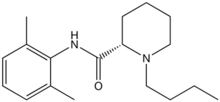- Levobupivacaine
-
Levobupivacaine 
Systematic (IUPAC) name (S)-1-butyl-N-(2,6-dimethylphenyl)
piperidine-2-carboxamideClinical data AHFS/Drugs.com Micromedex Detailed Consumer Information Pregnancy cat. B3(AU) Legal status Prescription Only (S4) (AU) Routes Parenteral Pharmacokinetic data Bioavailability n/a Metabolism Hepatic Half-life 2–2.6 hours Excretion Renal 70%, faecal 24% Identifiers CAS number 27262-47-1 
ATC code N01BB10 PubChem CID 92253 DrugBank APRD00110 ChemSpider 83289 
UNII A5H73K9U3W 
ChEBI CHEBI:6149 
ChEMBL CHEMBL1201193 
Chemical data Formula C18H28N2O Mol. mass 288.43 g/mol SMILES eMolecules & PubChem  (what is this?) (verify)
(what is this?) (verify)Levobupivacaine (rINN) (
 /liːvoʊbjuːˈpɪvəkeɪn/) is a local anaesthetic drug belonging to the amino amide group. It is the S-enantiomer of bupivacaine. [1]
/liːvoʊbjuːˈpɪvəkeɪn/) is a local anaesthetic drug belonging to the amino amide group. It is the S-enantiomer of bupivacaine. [1]Levobupivacaine hydrochloride is commonly marketed by Abbott under the trade name Chirocaine.[2]
Contents
Clinical use
Compared to bupivacaine, levobupivacaine is associated with less vasodilation and has a longer duration of action. It is approximately 13 percent less potent (by molarity) than racemic bupivacaine.
Indications
Levobupivacaine is indicated for local anaesthesia including infiltration, nerve block, ophthalmic, epidural and intrathecal anaesthesia in adults; and infiltration analgesia in children.
Contraindications
Levobupivacaine is contraindicated for IV regional anaesthesia (IVRA).
Adverse effects
Adverse drug reactions (ADRs) are rare when it is administered correctly. Most ADRs relate to administration technique (resulting in systemic exposure) or pharmacological effects of anesthesia, however allergic reactions can rarely occur.
Systemic exposure to excessive quantities of bupivacaine mainly result in central nervous system (CNS) and cardiovascular effects – CNS effects usually occur at lower blood plasma concentrations and additional cardiovascular effects present at higher concentrations, though cardiovascular collapse may also occur with low concentrations. CNS effects may include CNS excitation (nervousness, tingling around the mouth, tinnitus, tremor, dizziness, blurred vision, seizures) followed by depression (drowsiness, loss of consciousness, respiratory depression and apnea). Cardiovascular effects include hypotension, bradycardia, arrhythmias, and/or cardiac arrest – some of which may be due to hypoxemia secondary to respiratory depression.[3]
References
- ^ Burlacu CL, Buggy DJ (April 2008). "Update on local anesthetics: focus on levobupivacaine". Ther Clin Risk Manag 4 (2): 381–92. PMC 2504073. PMID 18728849. http://www.pubmedcentral.nih.gov/articlerender.fcgi?tool=pmcentrez&artid=2504073.
- ^ Rossi S, editor. Australian Medicines Handbook 2006. Adelaide: Australian Medicines Handbook; 2006. ISBN 0-9757919-2-3
- ^ Rossi S, editor. Australian Medicines Handbook 2006. Adelaide: Australian Medicines Handbook; 2006. ISBN 0-9757919-2-3
Anesthetics: Local anesthetics - primarily sodium channel blockers (N01B) Esters Amylocaine • Benzocaine • Butacaine • Butamben • Chloroprocaine • Dimethocaine • Meprylcaine • Metabutoxycaine • Orthocaine • Propoxycaine • Procaine (Novocaine) • Proxymetacaine • Risocaine • TetracaineAmides Articaine • Bupivacaine # /Levobupivacaine/Ropivacaine • Carticaine • Cinchocaine • Etidocaine • Lidocaine # • Mepivacaine • Prilocaine • TrimecaineCombinations Categories:- Local anesthetics
- Enantiopure drugs
- Piperidines
- Anilides
Wikimedia Foundation. 2010.
